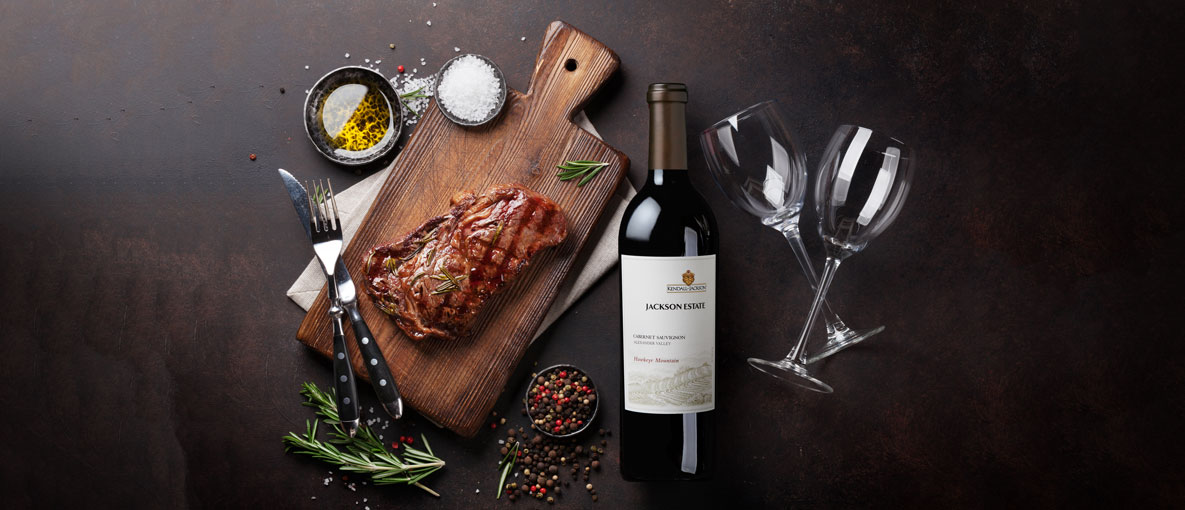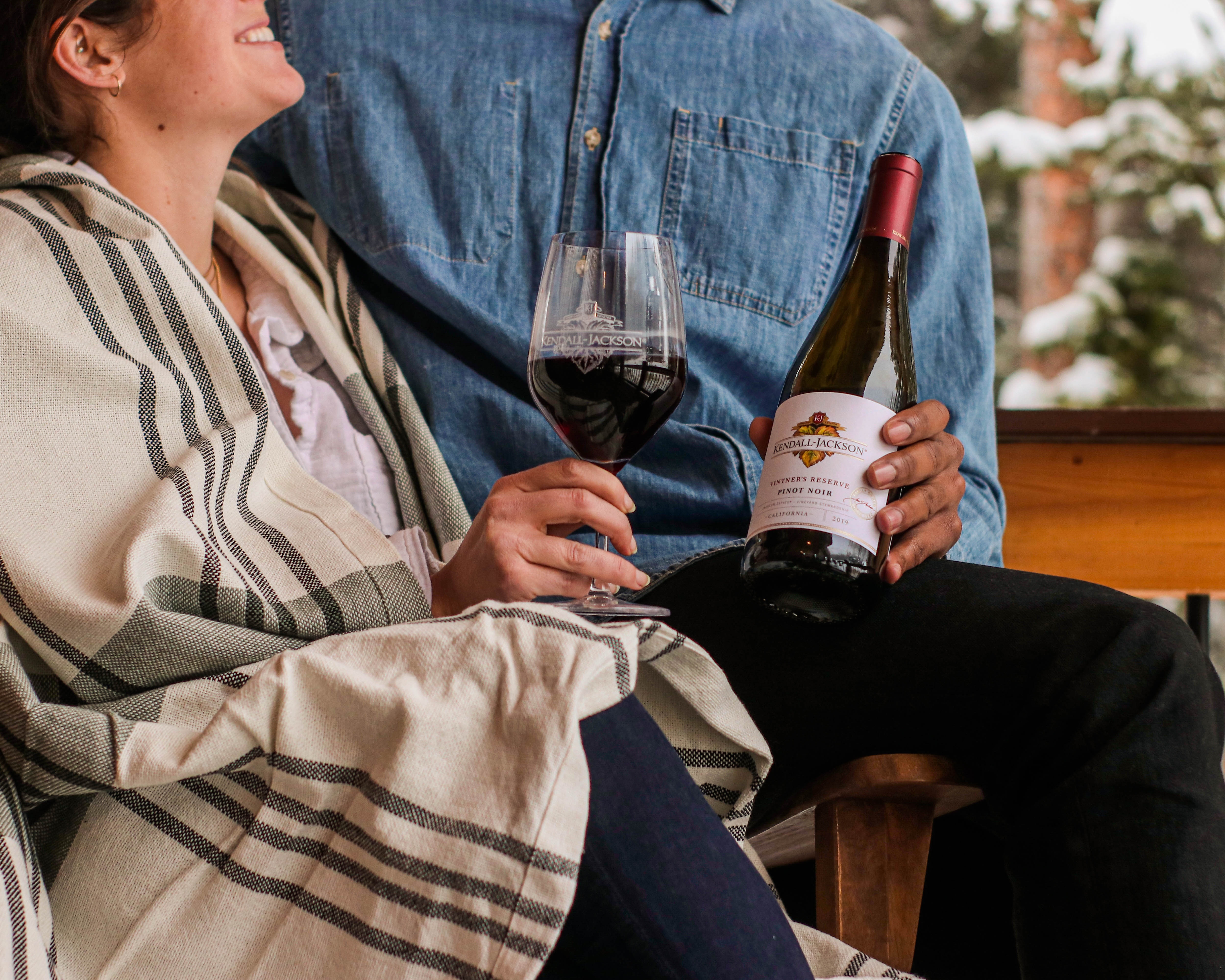Pairing Wine with Summer Fruits and Vegetables
Joy! Summer produce begins to fill the bins in grocery stores and farmers’ markets stalls at last!
At Kendall-Jackson, the Farm-to-Table Dinner Series runs from July through October, with its diverse array of local ingredients that are used to highlight the Jackson family’s top rated California wines. There’s no better time than the summer to “work on” (if we must) loving our veggies and fruits as so many of them blossom into their peak seasons over the next few months.
What’s one of the best parts of this summer eating mindset? Wine is made from fruit, too, so there is absolutely a place on the table for fermented juice!
The rise in plant-based diets is another good reason to investigate vegetable pairings with wine and fruit pairings with wine. Whether we or our family members or friends are eating vegetarian or vegan or even if we’re still accompanying our sides with poultry and meat, fruit and vegetables are occupying more and more real estate on our plates.
If roughage comprises more of our intake, we should think more about how those elements pair with the wines in our glasses. Maybe the sides are as important as the mains? Or, are the sides now the mains? Below is our infographic showcasing a delightful array of summer fruits and vegetables. Explore the vibrant seasonal produce that adds freshness and flavor to your summer table.
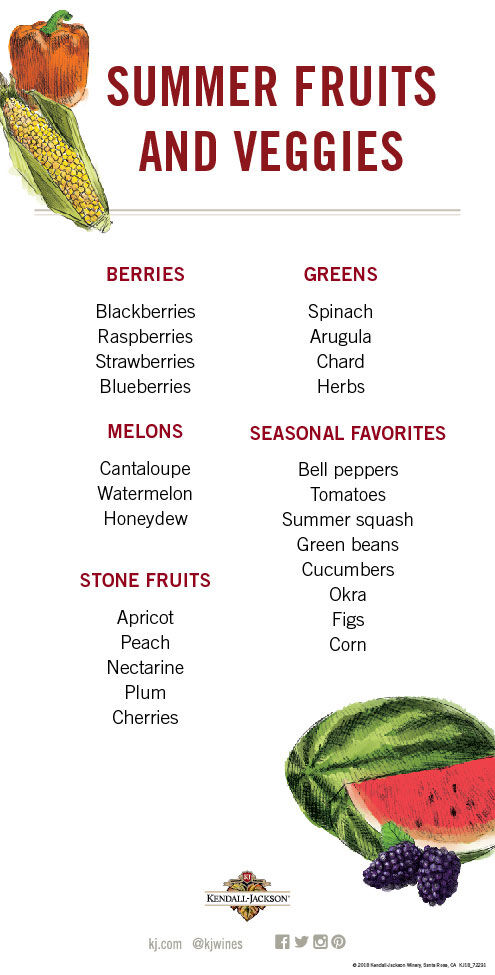
Key Tips on Pairing Wine with Summer Fruits and Vegetables
Let’s take a peek into how to pair wine with summer vegetables and fruits. Pairing wine with summer fruits and vegetables isn’t intuitive. There are almost no traditional wine pairings to syphon off, like pork pairing well with Pinot Noir and Cabernet Sauvignon matching up nicely with beef (even if some principles work between proteins and veggies and fruits – see below). That’s due in part to the raw ingredients and in part due to the preparation of fruits and vegetables. Like with proteins, that mid-step can dramatically change what works wine-wise.
Whereas you may simply eat a well-seasoned steak, it’s unlikely that you’re just eating “just” a well-seasoned squash. That squash might be cooked with onions or shallots, and maybe there’s some zucchini or herbs mixed in for contrasting color and flavor. Vegetables and fruits tend to be highly collaborative foods. That makes most of them fairly easy to pair with wine because they show a more diverse range of flavors.
Challenging Vegetable and Wine Pairings
But, there are always ornery ones. Pairing wine with artichoke and asparagus is a tough challenge in the veggie world. Both are high in umami and bitter elements, so they often insert an unpleasant contrast to the fruit-driven character of wine. That is especially the case when the wine has been aged with any new oak, which imparts notes of vanilla, caramel and torrefaction.
The good news is that these two difficult-for-wine foods work well with the same wines. Those wines are crisp and crunchy enough to cut through the food on the palate, provide a diversity of flavors, while a number of exotic and far-flung varieties can work, an unoaked, varietal Sauvignon Blanc is always a sure bet.
Rules of Thumb to Follow
Aside from the voluble variables, there are some solid rules of thumb to follow. They read a lot like wine rules for poultry and meat pairings. That is to say that “generally this with that“ wine pairings:
- The lighter the color of the produce, the lighter the style of the wine should be.
- Mind you, while this doesn’t mean that food and wine colors have to match, usually lighter colored wines do match up better with lighter colored foods. The same goes for the deeper spectrum end of the rainbow.
- The fresher and livelier – and the less cooked – a vegetable or fruit is, the more youthful the paired wine should be.
- Geek alert(!) but important to know: if there is no Maillard reaction (or effectively, cooking) with your food, the fresher and younger you should go with the wines. (Don’t serve sushi with a high-density, super-ripe and ambitiously oaked Cabernet Sauvignon. Skip the well-aged one, too.)
- Similarly, unless the Maillard reaction used in preparing a food, a dish will generally be best accompanied by a wine with less evident oak. Unless roasted or grilled, most produce works best with unoaked or lightly oaked wines.
Our Favorite Vegetable, Fruit and Wine Pairings
We worked with the culinary team and gardeners at the Kendall-Jackson Wine Estate & Gardens to pick terrific vegetable and wine and fruit and wine combinations using some of summer’s most popular produce. Not everyone geeks out over garlic scapes, and even those that do can’t always find them!
This pretty infographic shows inspirations for summer fruits and vegetables. While each is distinct, some have similar flavors. Not into green beans? How about a cucumber instead? Why not substitute black plums in the place of blackberries? If you think in terms of similar flavors – and depth of flavors, you can easily substitute different fruits and vegetables in the recipes below. You’ll be pairing white wines with vegetables and pairing red wines with fruits before you know it! Or vice versa. Fruit pairings with wine are some of the most intuitive combinations around.
Remember that if you’re curious about a new summer fruit or vegetable but aren’t sure how it tastes or how to prepare it, just ask. Your local farmer grows it or your grocer stocks it because she or he thinks it’s good. As the saying goes, they’re not standing behind these items for their health! They’d much rather get you hooked on them by suggesting how to use them rather than haul it all home – possibly to the compost pile – that night!
Pairing Summer Produce with Rosé
Summertime means fresh, vibrant flavors, and rosé wines are the perfect partners to these seasonal delights. Known for their versatility and refreshing acidity, rosés can complement everything from grilled seafood to light salads. Let's delve into some delicious pairings and explore which Kendall-Jackson rosé might be your perfect match!
Our Recommendation: Vintner’s Reserve Rosé
- Watermelon, strawberries, red plums and blackberries are flavors frequently encountered in rosés made from any grape variety or combination of them. So, rosé is a killer compliment to salads with fresh fruits, like a watermelon and feta salad. For straight-up salads like a watermelon and feta, I prefer the Vintner’s Reserve Rosé.
- Rosé is frequently pale pink, but it can also be richly colored. Remember the color matching principle here, but also remember that just because a rosé is dark in color doesn’t mean its sweet. In fact, fewer and fewer rosés are sweet these days. If you toss some protein into your salad or if you are just looking for some more flavor dynamism, opt for our Jackson Estate Rosé.
- Dry rosés are super food-friendly and do an impressive job of spanning the bridge between white and red wine styles.
- Rosé is excellent at vegetable wine pairings!
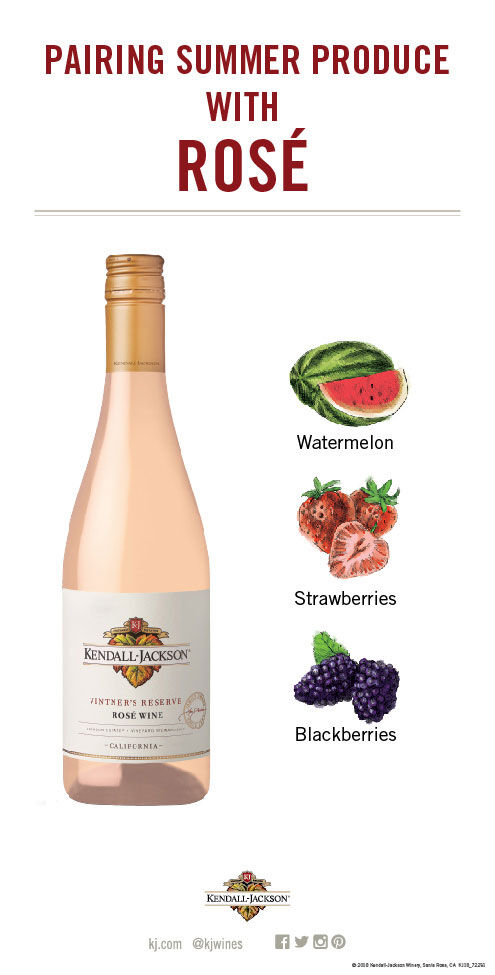
Pairing Summer Produce with Chardonnay
Chardonnay takes on a new summer personality. Forget heavy oak and buttery textures – think refreshing acidity and hints of citrus. These lighter styles sing alongside vibrant summer produce, highlighting their natural sweetness and freshness. Let's explore some delicious pairings and see which Kendall-Jackson Chardonnay becomes your summer go-to!
Our Recommendation: Vintner’s Reserve Chardonnay
- Chardonnay can be a real chameleon style-wise. When kissed with some oak, Chardonnay works incredibly well with a Grilled Summer Corn Salad. That’s because corn is inherently sweet and Chardonnay often has some oak barrel aging that gives it a toasty edge, just like the (Maillard) effects of the grill.
- Top that salad up with the additional succulence of sweet red bell peppers and avocado, and you can rev up your match to the Grand Reserve Chardonnay!
- Still, if you prefer your corn straight off the grill – or maybe just boiled if you got caught in a summer rainstorm, stick with the K-J AVANT Chardonnay. It will match your corn’s sweetness and not overwhelm your simple masterpiece with oaky tones.
- Yes, you really can have white wine AND eat your veggies, too!
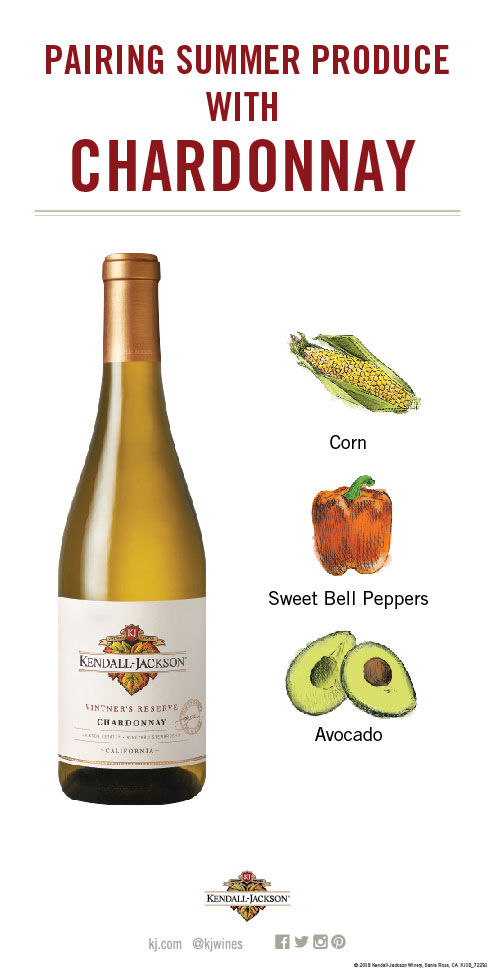
Pairing Summer Produce with Sauvignon Blanc
Sauvignon Blanc bursts onto the scene like a burst of sunshine in a glass. Its hallmark characteristic? Vibrant acidity and herbaceous notes that perfectly complement the verdant flavors of summer. Think of it as a melody that lifts the freshness of your favorite seasonal produce. Let's explore some pairings that will have your taste buds singing, and discover the perfect Kendall-Jackson Sauvignon Blanc to complete the symphony!
Our Recommendation: Vintner’s Reserve Sauvignon Blanc
- Green produce melds beautifully with Sauvignon Blanc’s herbal tones. Sauvignon Blanc is the unique in the white wine category because it embraces herbals tones in a positive manner. (Cabernet Franc does it in the red grape variety camp. It’s usually included in blends in the US but found as a varietal wine in the Loire Valley of France.)
- Fava Bean and Asparagus Sautée is an excellent pairing for “green things” with Sauvignon Blanc. It also works in the difficult asparagus element, but it does so with ease.
- Other white wine and vegetable pairings to consider include cucumbers, green beans and other “green” tones that lend well to pairing with citrusy elements, especially lemon tones, and salty nuances, too.
- Watching your calories? We also make the best low calorie wines including Sauvignon Blanc as well!
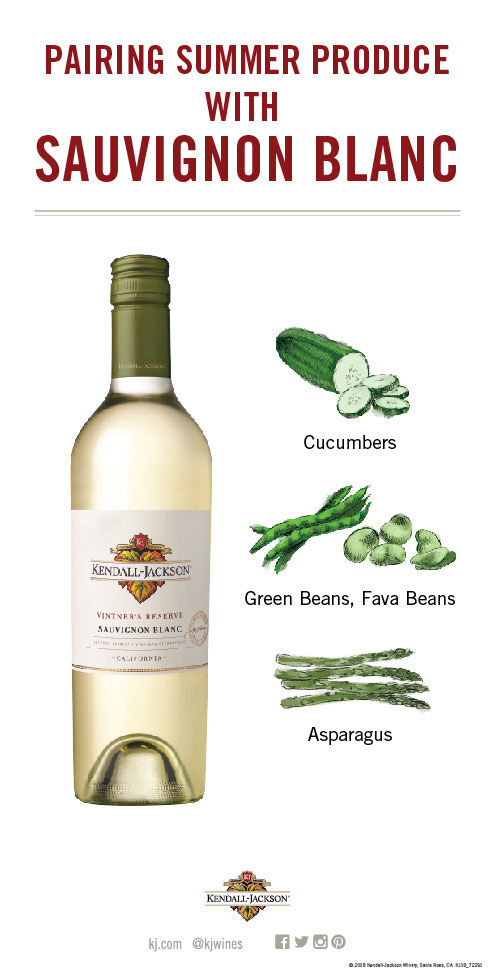
Pairing Summer Produce with Pinot Noir
Pinot Noir is the ultimate summer red. Unlike bolder reds, it thrives in cooler climates, resulting in a lighter-bodied wine with refreshing acidity. This makes it a fantastic partner for a wide range of summer dishes, letting the vibrant flavors of the season shine through. Think of it as a supporting actor, enhancing the natural sweetness and freshness of your meal. Let's explore some delectable pairings and discover the perfect Kendall-Jackson Pinot Noir to elevate your summer feast!
Our Recommendation: Vintner’s Reserve Pinot Noir
- Pinot Noir often behaves like a white wine in that it meshes best with lighter dishes.
- It is a grape variety that tends to be grown in cooler climates, so its resulting wines can blend nicely with a range of summer garden bounty flavors.
- A favorite here is summer squash noodles with pesto. Similarly, densely green flavors – like kale and collard greens – can work nicely, too. The darker you go with the green flavors, the more important it is to keep an aspect of refreshment or liveliness, like sundried tomatoes.
- As the Kendall-Jackson reds above the Vintner’s Reserve level tend to have more oak, I suggest saving those wines for heartier or meat-inspired dishes for chillier season dinners.
- Check out our full selection of top rated Pinot Noir wines.
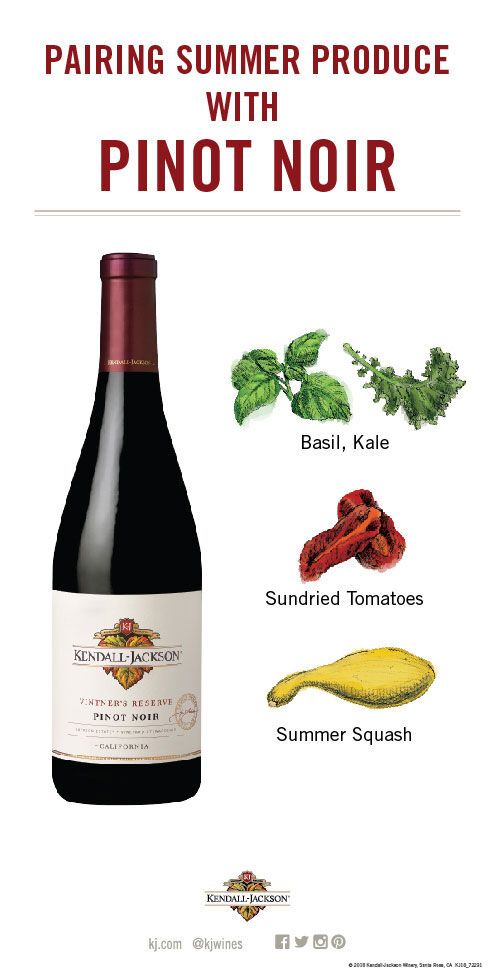
Pairing Summer Produce with Cabernet Sauvignon
Cabernet Sauvignon might not be the first wine that comes to mind for summer, but it can be a surprisingly delightful partner for the season's bounty. Think beyond the traditional steak pairing and explore the world of cheese and fruit! Cabernet Sauvignon's bold structure complements the richness of creamy cheeses, while its fruit notes find harmony with the sweetness of summer berries. Let's create a winning summer cheeseboard and discover the perfect Kendall-Jackson Cabernet Sauvignon to complete the experience!
Our Recommendation: Vintner’s Reserve Cabernet Sauvignon
- A summer cheeseboard is the best! Also, it seems like so many of us start to appreciate wine pairings with cheeses and fruit served. You get all the goodness of sweet, spring milk cheeses to munch with the bountiful and delightfully ripe fruits of summer. Moreover, in some ways, this is the ultimate farm-to-fork option as there is arguable the least manipulation is fruit use with this pairing. This is also a great red wine pairing for vegetarians!
- Mind you, with a red wine pairing, it makes sense to stay in the flavor spectrum of fruits one would find in red wines, and especially in chunky red wines. Though denser in flavor than their fresh counterparts, candied or jammed fruits that are in the citrus and pit fruit families won’t work particularly well here. Plums, cherries and berries are where this is at!
- Creamy style cows milk cheeses work brilliantly with Cabernet Sauvignon, as they prove to be a foil for Cabernet’s firm structure. Top choices favored by K-J Cheese Guru Tracey Shepos include Mt Tam by Cowgirl Creamery and Saint-André from France. Two of my favorite USA blues include Original Blue by Point Reyes Farmstead Cheese and Maytage Blue Cheese by Maytag Dairy Farms in Iowa.
- Creamy cows’ milk cheeses may work best with fresh fruits, but aged sheep milk cheeses can work nicely, too, assuming they have not become too salty from long-term aging. Alas, goats milk cheeses almost never work (but they totally rock it with Sauvignon Blancs), even when made in an aged Gouda style.
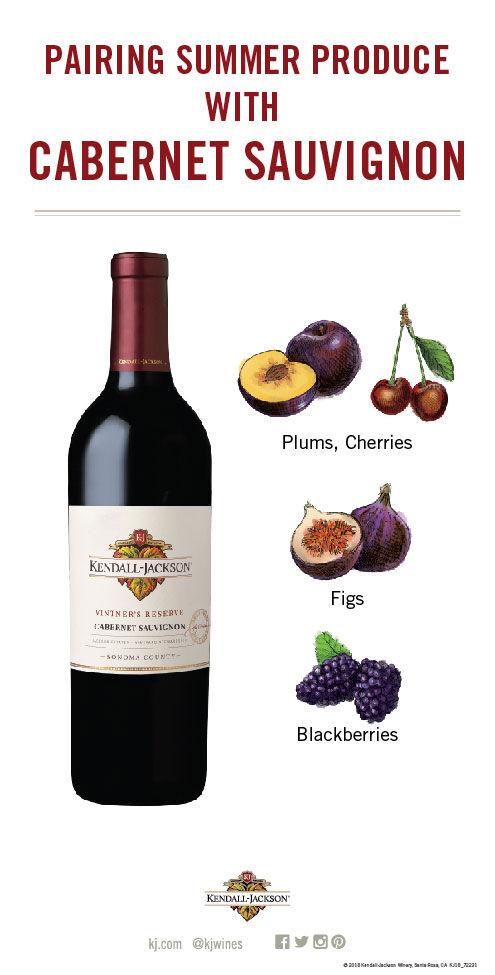
In summary, pairing wines with summer fruits and vegetables isn’t so hard with a few pairing principles in your back pocket. Keep lighter foods with lighter wines, and stay away from wines that see oak influence, unless you are grilling.
For more wine pairing suggestions, including How to Pair Wine with Heirloom Tomatoes, explore the entertaining page of our website.
Unveiling the Perfect Summer Pairing: Kendall-Jackson and Summer Produce
Summer is a symphony of fresh flavors, and Kendall-Jackson wines are the perfect accompaniment. Explore our diverse portfolio and discover how each bottle elevates the vibrant essence of the season. From crisp Sauvignon Blancs that dance with verdant vegetables to bold Cabernet Sauvignons that complement a decadent cheeseboard, Kendall-Jackson offers a wine for every summer soiree.
Ready to embark on your own pairing adventure? Shop our complete selection of wines and find your perfect match for those long summer nights. Cheers!
Christy Canterbury is a Master of Wine, journalist, speaker and judge based in New York City. In 2014, she was short-listed for the Roederer Online Wine Communicator of the Year Award. Her work has been published in Decanter, Wine Enthusiast, Edible Green Mountains, Wine Searcher, Food Arts, Snooth, Beverage Media, TimAtkin.com, Civiltà del Bere, Wine Business Monthly, TASTED, Selectus Wines and in other outlets.

